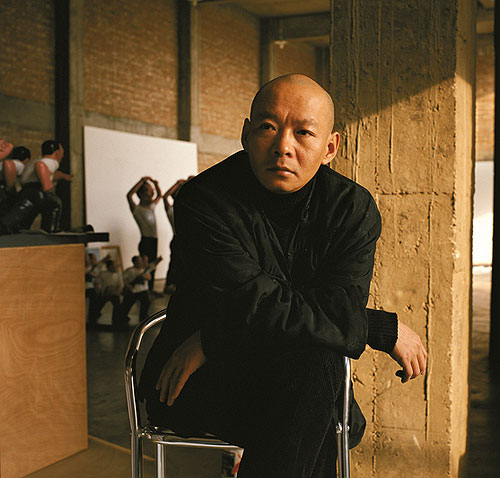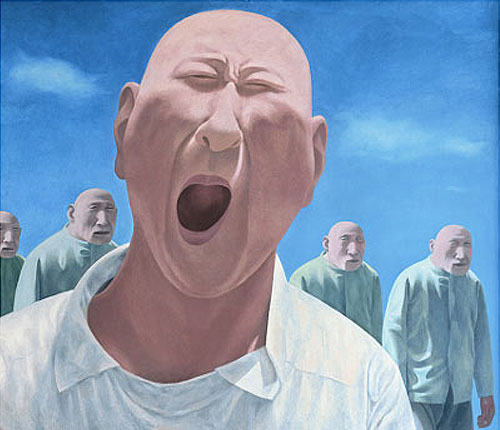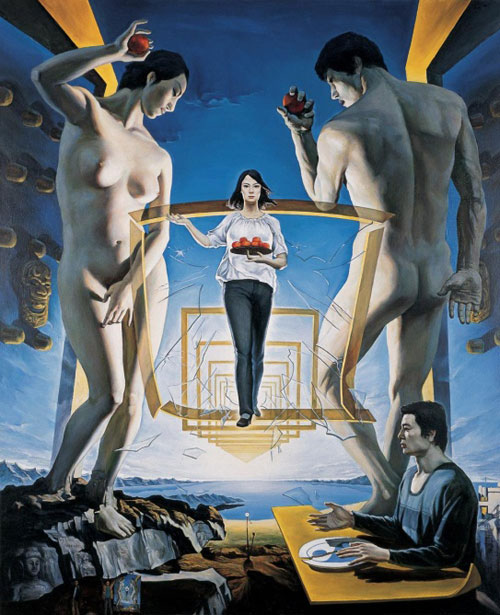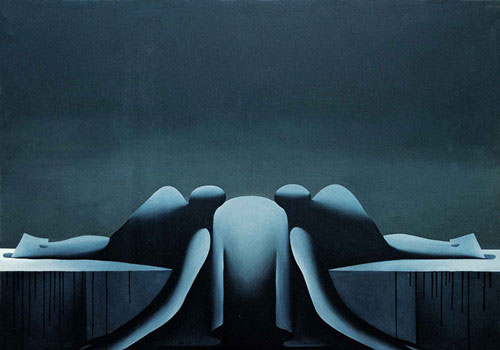Free Sky -2
Oil on canvas: height 100cm, width 90cm
Time of creation: 2012
Collected by Hunan Provincial Museum in 2014
This Free Sky – 2 was created by Yue Minjun, a contemporary Chinese artist. The figure depicted in the painting is in an ecstasy of delight, laughing heartily in an exaggerated way. This is the typical image painted by the artist. His other noticeable features include the simple strokes resembling the creation of commercial ads and the use of plain colors. Beginning in the 1990s, Yue Minjun painted many figures making odd and ludicrous movements and grinning cheekily. As one of the important representatives of Cynical Realism, Yue is regarded as the one of the “Four Key Artists in Contemporary Chinese Art”, together with Zhang Xiaogang, Fang Lijun and Wang Guangyi.

Yue Minjun
Yue Minjun was born in Daqing, Heilongjiang province in 1962. His ancestral home was located in Yiyang, Hunan province. He was admitted into the Department of Art in Hebei Normal University in 1985. Since the early 1990s, Yue Minjun started his oil painting on canvas, creating a “self-image” in an exaggerated way. Later, such an image was adopted into the fields of sculpture and engraving. With its distinctive image and features, Yue Minjun plays a very important role in contemporary Chinese art circle.
Author: Shi Youwen
深入探索
What is “Cynical Realism” ?
At the beginning of the 1990s, a new artistic trend developed in art exhibitions in Beijing. The trend was characterized by tedium and the Hippie’s humor and cynicism. The style of Yue Minjun’s artistic creation was established during this trend and gradually developed with it. All the images he created were very similar, laughing at themselves, which embodied the tedious life and Hippie’s humor in their existence that the Chinese people were experiencing at the late 1980s and the early 1990s. Such a kind of existence was also depicted by writers like Wang Shuo and singers like Cui Jian. These art works became a symbol of the cultural mentality and social mentality of that specific era in China. Fang Lijun was another artist in this trend. His work entitled A Yawning Man was published on the cover of the American magazine Times on November 19, 1993. In the painting, a bald man is giving a yawn, whose face occupies much of the space. The colors used are very plain. It reflects a kind of mental state filled with boredom and emptiness.

A Yawning Man, Fang Lijun.
At the late 1980s and the early 1990s, Chinese artists had a hard time as the old value system collapsed while the new one had not been established yet. As for artists in the 1980s, they embraced the modern ideas from the Western countries, which laid a foundation for their artistic creation. Their source of inspiration came from the modern Western art, including the quest into philosophical issues and the use of simple artistic symbols. Here are two examples: In the New Era: the apocalypse from Adam and Eve, co-created by Zhang Qun and Meng Luding, embodied the idealistic elements; Post-classicism: the end of Marat, created by Wang Guangyi, one of the active members in “Northern Art School”, embodied philosophical meanings with a sense of solemnity.

In the New Era: the apocalypse from Adam and Eve, Zhang Qun and Meng Luding

Post-classicism: the end of Marat, Wang Guangyi
。
相关评论
1.栗宪庭, 当前中国艺术的无聊感—— 析玩世现实主义潮流,《二十一世纪》,1992年2月号,总第9期;《艺术潮流》,1992年创刊号




